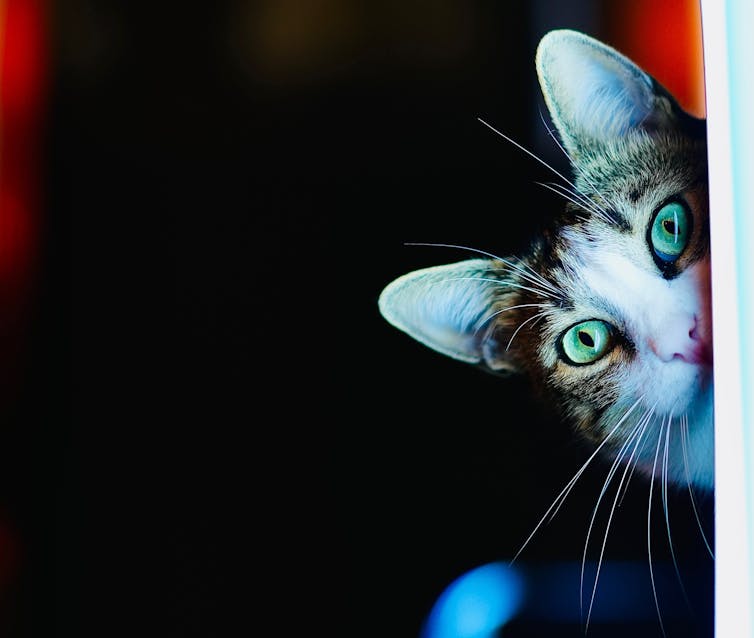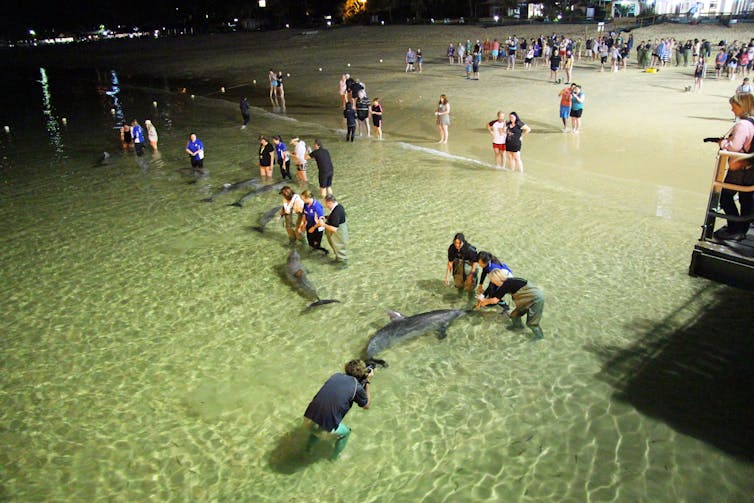Although cats were domesticated over 10,000 years ago, their instinct to hunt for survival is still very strong.
What do a little penguin, a baby rabbit, a black rat and a Krefft’s glider have in common? They’ve all been presented to me (when dead) by my animal companions. Chances are, if you live with a cat or dog, you’ve also been brought something similar.
So, is it a gift, are they showing off, or is something else going on?
 Samantha Fortney/Unsplash, CC BY
Samantha Fortney/Unsplash, CC BY
Is it meant for you?
The first thing to consider is whether your canine or feline companion is actually bringing you the dead animal, or are you just in the space they have also come to?
As people, we tend to like putting ourselves into the middle of every story (the fancy term to describe this mindset is anthropocentric). But sometimes it’s not about us. Maybe your dog was planning to munch away at that half-rotten critter on their comfortable bed in a known safe place, which coincidentally is near where you are.
Read more: Genetic research confirms your dog's breed influences its personality — but so do you
Perhaps your cat has entered the room, truly parading the find in their mouth to you. This might include them loudly exclaiming they hit their version of the jackpot with a direct approach: walking towards you, holding eye contact with you and making a distinctive cry (most cat meows are designed to get your attention).
If this is the case, then yes, they probably are intentionally sharing this dead animal with you. But why?
Understanding animal motivations
Did they kill this animal themselves?
Globally, we know people value wildlife in both urban and rural areas. Yet our companion cats and dogs kill huge numbers of wild animals. In Australia, cats in particular have attracted attention and management policies to reduce their impact on local wildlife.
 They can be very cute, but cats are also highly effective killers of native wildlife. Fatih Turan/Pexels, CC BY
They can be very cute, but cats are also highly effective killers of native wildlife. Fatih Turan/Pexels, CC BY
Are they bringing you something that was already dead?
In some situations, our animals may just be opportunistic and have found something that was already dead. Perhaps it was dropped in a paddock by an owl, or washed up on the beach, or hit by a vehicle and found on the side of a road. What are we to make of these offerings?
In 2015, Queensland biologists described a number of individual wild bottlenose dolphins apparently “gift-giving” wild-caught fish (usually already dead) or cephalopods (such as squid and octopus) to the people who fed them fish as part of a regulated feeding program at Tangalooma in Australia.
The researchers thought the gifting was consistent with play, prey-sharing and teaching behaviors observed in dolphins, whales and many other mammals historically considered as big thinkers.
Ultimately, with these dolphins, and with our own animal companions, we can think of this sharing as an expression of the particular relationship between the animal and the human. In some cases, where the behavior is regular (even if infrequent), we can describe it as part of the animals’ culture, as the dolphin biologists did in their scientific paper.
Read more: Whales and dolphins have rich cultures – and could hold clues to what makes humans so advanced
 Dolphins used to being fed by people at Tangalooma, Queensland, have been known to present fish in return. S. Newrick/Wikimedia Commons, CC BY-SA
Dolphins used to being fed by people at Tangalooma, Queensland, have been known to present fish in return. S. Newrick/Wikimedia Commons, CC BY-SA
What should you do?
If you ever find yourself in the position where your animal companions bring you a dead animal, there are a couple of things to remember.
Regular parasite control will ensure you don’t all share more than intended. Mites responsible for mange, lice and worms can all spread readily between dead wildlife, animal companions and people. Talk to your veterinarian if you’re unsure about what parasite control your four-legged friend should routinely have.
Stopping cats and dogs from preying on wildlife is a really important part of looking out for everyone’s wellbeing. If you know your animal companion is killing wild animals, you should take action to prevent it.
Effective measures might include safely limiting when and where they go outdoors, a bell on their collar, keeping them on a lead when outside, and redirecting their energy through regular walks, play and fun training activities. Keeping cats inside the home can also limit the spread of diseases to humans and other animals.
Read more: Cats that are allowed to roam can spread diseases to humans and wildlife
So, when your cat or dog presents you with a dead animal, it is normal behavior and can indicate their attachment to you. It’s also a reminder, though, of how much damage they can do to wildlife and of our responsibility to limit that harm.
Mia Cobb does not work for, consult, own shares in or receive funding from any company or organization that would benefit from this article, and has disclosed no relevant affiliations beyond their academic appointment.
This article is republished from The Conversation under a Creative Commons license.
5 common dog myths and the facts behind them
Sniffing out the truth
Updated
There are countless myths about our pets — some so old they have become facts in the eyes of many people. While some of these myths are harmless, many are filled with misinformation about a dog’s care, temperament, behavior and intelligence. Pet owners who act on this misinformation may not be meeting the needs of their dog.
To separate fact from fiction, the American Kennel Club clears up some well-known myths about dogs.
Myth No. 1: A wagging tail means a happy dog
Updated
The truth: A wagging tail does not always mean the dog is happy. While a natural, midlevel wagging tail does indicate the dog is content, most other wags indicate the opposite.
A high, stiff wagging tail can be a sign of agitation in the dog, suggesting they are ready to protect something, while a low and quick wag may express the dog is scared and submissive.
Myth No. 2: Dogs age seven years for every human year
Updated
The truth: This myth has been around for so long most people see it as a fact. Although dogs do age quicker than humans, the 7:1 ratio is not perfectly accurate.
Dogs age faster when they are younger, and then the aging process slows down as they get older.
The size of the dog also plays a role in the aging process — larger dogs age faster than small dogs.
Myth No. 3: A warm nose indicates sickness
Updated
The truth: The idea that a dog in good health should have a cold, wet nose is nothing more than another myth. The temperature of a dog’s nose does not represent health or sickness. Using a thermometer is the only way to accurately measure your dog’s temperature.
Myth No. 4: Old dogs can’t learn new tricks
UpdatedThe truth: You can absolutely teach an older dog new tricks, like how to shake hands, speak or roll over. Keeping the training sessions short and fun while using plenty of positive reinforcement like treats and praise can help make the training process easier.
Myth No. 5: Dogs can’t see in color
UpdatedThe truth: At one point in time, it was believed dogs could only see in black, white and shades of gray. This myth is still believed by many people today. Dogs have fewer color-sensitive cones in their eyes than humans do. However, it has been discovered that although it’s not in the same way as humans, dogs can in fact see color. They can see blue, green-ish yellow and yellow along with various shades of gray.



